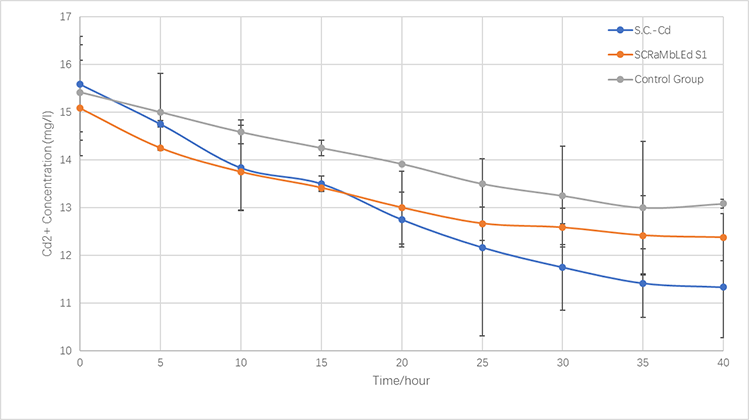Cccxyyyyyyyy (Talk | contribs) |
|||
| Line 481: | Line 481: | ||
<div id="pic_fortythree" style="display:none;"><img src="https://static.igem.org/mediawiki/2017/0/0a/Chenxiyuyuantu2.jpg"><p style="font-size:15px;text-align:center"><br/>Fig 2-4. Three modified colonies and one resulting colony.</div> | <div id="pic_fortythree" style="display:none;"><img src="https://static.igem.org/mediawiki/2017/0/0a/Chenxiyuyuantu2.jpg"><p style="font-size:15px;text-align:center"><br/>Fig 2-4. Three modified colonies and one resulting colony.</div> | ||
| − | <p>The upper left corner of the | + | <p>The upper left corner of the microorganism is synthetic <i>Saccharomyces cerevisiae</i>, we integrated modified fragment into its <i>synthetic chromosome V</i>. (<b><i>PVUVC</i></b>) The upper right corner is also synthetic <i>Saccharomyces cerevisiae</i>. (<b><i>PVRVC</i></b>) It is imported <i>red fluorescent protein</i> gene based on the upper left corner of the yeast. Both of them are single-celled organism called a. The lower right corner of the yeast is another mating type of haploid yeast called α. It has plasmid <i>pRS416</i> with <i>vika</i> gene. The yeast in the lower left corner are diploid <i>Saccharomyces cerevisiae</i>, which is obtained by mating the two yeasts on the right side of the figure.</p> |
<p>The yellow colony in the figure is mating successfully. After the induction of <i>galactose</i>, <i>vika recombinase</i> was expressed, and <i>red fluorescent protein</i> gene and terminator was deleted so that <i>β-carotene</i> expresses. The color of colony was changed from white to yellow. In addition to it, we also tried other methods to turn on the switch.</p> | <p>The yellow colony in the figure is mating successfully. After the induction of <i>galactose</i>, <i>vika recombinase</i> was expressed, and <i>red fluorescent protein</i> gene and terminator was deleted so that <i>β-carotene</i> expresses. The color of colony was changed from white to yellow. In addition to it, we also tried other methods to turn on the switch.</p> | ||
| Line 490: | Line 490: | ||
<a href="#pic_fortyfour"> | <a href="#pic_fortyfour"> | ||
<img src="https://static.igem.org/mediawiki/2017/9/98/Yasuo3333.png"></a> | <img src="https://static.igem.org/mediawiki/2017/9/98/Yasuo3333.png"></a> | ||
| − | <p style="font-size:15px;text-align:center"><br/>Fig 2-5. | + | <p style="font-size:15px;text-align:center"><br/>Fig 2-5. Yeast after mating cultivated on the Sc-His plate.</p> |
</div> | </div> | ||
</div> | </div> | ||
| − | <div id="pic_fortyfour" style="display:none;"><img src="https://static.igem.org/mediawiki/2017/7/77/Tianjin-3-Bacteria_after_mating_cultivated_on_the_Sc-His_plate_yuantu.png"><br/>Fig 2-5. | + | <div id="pic_fortyfour" style="display:none;"><img src="https://static.igem.org/mediawiki/2017/7/77/Tianjin-3-Bacteria_after_mating_cultivated_on_the_Sc-His_plate_yuantu.png"><br/>Fig 2-5. Yeast after mating cultivated on the Sc-His plate.</p></div> |
<p>There are 377 yellow colonies and 365 white colonies in the field of view.</p> | <p>There are 377 yellow colonies and 365 white colonies in the field of view.</p> | ||
<p>We used another α-type yeast named <i>BY4742</i>, which has a plasmid called <i>pRS413</i> with selective marker <i>His</i>. It could express <i>vika recombinase</i> before mating. It mated with a-type <i>Saccharomyces cerevisiae</i> <b><i>PVRVC</i></b>, and then yeast cultured on Sc-His plate. As can be seen from the figure above, the reorganization efficiency is high, which reaches 50.8 percent. This proves that our Mating switcher is fast and efficient.</p> | <p>We used another α-type yeast named <i>BY4742</i>, which has a plasmid called <i>pRS413</i> with selective marker <i>His</i>. It could express <i>vika recombinase</i> before mating. It mated with a-type <i>Saccharomyces cerevisiae</i> <b><i>PVRVC</i></b>, and then yeast cultured on Sc-His plate. As can be seen from the figure above, the reorganization efficiency is high, which reaches 50.8 percent. This proves that our Mating switcher is fast and efficient.</p> | ||
| Line 504: | Line 504: | ||
<a href="#pic_fortyfive"> | <a href="#pic_fortyfive"> | ||
<img src="https://static.igem.org/mediawiki/2017/8/81/Tianjin-4-Bacteria_after_mating_cultivated_on_the_Sc-Ura_plate.png"></a> | <img src="https://static.igem.org/mediawiki/2017/8/81/Tianjin-4-Bacteria_after_mating_cultivated_on_the_Sc-Ura_plate.png"></a> | ||
| − | <p style="font-size:15px;text-align:center"><br/>Fig 2-6. | + | <p style="font-size:15px;text-align:center"><br/>Fig 2-6. Yeast after induction cultivated on the Sc-Ura plate.</p> |
</div> | </div> | ||
</div> | </div> | ||
| − | <div id="pic_fortyfive" style="display:none;"><img src="https://static.igem.org/mediawiki/2017/6/6d/Tianjin-4-Bacteria_after_mating_cultivated_on_the_Sc-Ura_plate_yuantu.png"><br/>Fig 2-6. | + | <div id="pic_fortyfive" style="display:none;"><img src="https://static.igem.org/mediawiki/2017/6/6d/Tianjin-4-Bacteria_after_mating_cultivated_on_the_Sc-Ura_plate_yuantu.png"><br/>Fig 2-6. Yeast after induction cultivated on the Sc-Ura plate.</p></div> |
<p>There are 325 yellow colonies and 31 white colonies in the field of view.</p> | <p>There are 325 yellow colonies and 31 white colonies in the field of view.</p> | ||
<p>Apart from mating, we also transformed plasmid <i>pRS416</i> with <i>vika</i> gene into the <b><i>PVRVC</i></b>. The efficiency is up to 91.3 percent in this figure.</p> | <p>Apart from mating, we also transformed plasmid <i>pRS416</i> with <i>vika</i> gene into the <b><i>PVRVC</i></b>. The efficiency is up to 91.3 percent in this figure.</p> | ||
| Line 542: | Line 542: | ||
<p>To sum up, the mating switcher can be presented in kinds of yeast with different forms. This proves that our Mating switcher is fast, flexible and efficient.</p> | <p>To sum up, the mating switcher can be presented in kinds of yeast with different forms. This proves that our Mating switcher is fast, flexible and efficient.</p> | ||
| − | <p>Meantime, we cultured the transformed yeast in several 5mL liquid <i>SC-Leu</i> at 30℃ and 220 rpm for 12 hours ( Take three samples at a time). We used one sample for centrifugation to precipitate the | + | <p>Meantime, we cultured the transformed yeast in several 5mL liquid <i>SC-Leu</i> at 30℃ and 220 rpm for 12 hours ( Take three samples at a time). We used one sample for centrifugation to precipitate the yeast and the remaining two remained unchanged. The difference is the fluorescence value we need, then we calculated the value of average them. The excitation wavelength is set at 540nm and the emission wavelength is set at 635nm. Hereafters, we measured the yeast concentration at OD<sub>600</sub>. At last, we divided the fluorescence value by OD<sub>600</sub> to normalize the value and the result data is as follows. |
</p> | </p> | ||
<div class="zxx_zoom_demo_qqqqq" align="center"> | <div class="zxx_zoom_demo_qqqqq" align="center"> | ||
| Line 876: | Line 876: | ||
</div> | </div> | ||
| − | <div id="pic_eighty_one" style="display:none;"><img src="https://static.igem.org/mediawiki/2017/ | + | <div id="pic_eighty_one" style="display:none;"><img src="https://static.igem.org/mediawiki/2017/e/e7/Tianjin-Demonstrate-Han-4-4-da.png"><p style="font-size:15px;text-align:center"><br/>Fig. 4-4. structure of redesigned CUP1 promoter used in our project, based on BBa_K2165004 </p></div> |
Revision as of 05:38, 1 November 2017
/* OVERRIDE IGEM SETTINGS */
























































